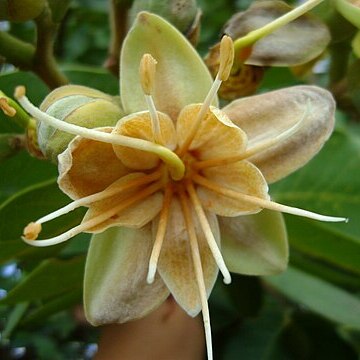Trees. Stipules caducous. Leaves bifoliolate, petiolate. Leaflets pellucid-punctate. Inflorescences terminal, paniculate or corymbose-paniculate; bracts and bracteoles caducous. Flowers pedicelled, all parts pellucid-punctate. Hypanthium narrowly campanulate. Calyx lobes 4, imbricate. Petals 5, subequal, slightly zygomorphic, imbricate. Disk absent. Stamens 10, free, exserted; filaments folded in bud, more or less equal in length; anthers dorsifixed and versatile, longitudinally dehiscent. Ovary stipitate, excentric with adnate stipe, 3-15-(or more-)ovuled. Pods indehiscent, woody, 3-8-(or more-)seeded. Seeds non-arillate, exalbuminous.
Unarmed resinous trees, with spreading crown. Leaves 1-jugate, petiolate; leaflets 2, obliquely asymmetric, coriaceous, glandular-punctate, short-petiolulate to subsessile. Inflorescence terminal, short, subcorymbose. Flowers moderately large, with a short, gross, pedicel and thick receptacle; calyx 4-parted, the lobes imbri-cate; petals 5, slightly unequal, sessile, glandular; stamens 10, free, glabrous; anthers longitudinally dehiscent; ovary few-ovulate, short-stipitate, the stipe adnate to the receptacular portion of the calyx; style slender; stigma terminal. Legume ligneous, thick, indehiscent, few-seeded; seeds exarillate.
Flowers in panicles, spirally arranged on the ultimate axes; bracts concave, caducous; bracteoles 2, enclosing the young bud, imbricate, caducous.
Pods ovoid or ellipsoidal, the epicarp hard with numerous prominent resin-filled vesicles, indehiscent; endocarp pithy-powdery.
Leaves with a single pair of leaflets, with pellucid gland dots; petiolules short, twisted; stipules small, early caducous.
Ovary stipitate; ovules usually 4; style elongated, filiform; stigma terminal, small.
Stamens 10; anthers dorsifixed, dehiscing by longitudinal slits.
Petals 3 large and 2 minute; sometimes all 5 large.
Sepals 4, unequal (2 + 2), imbricate.
Seeds 1–3, without areole or aril.
Trees, evergreen, unarmed.
Hypanthium short.
A tree.

